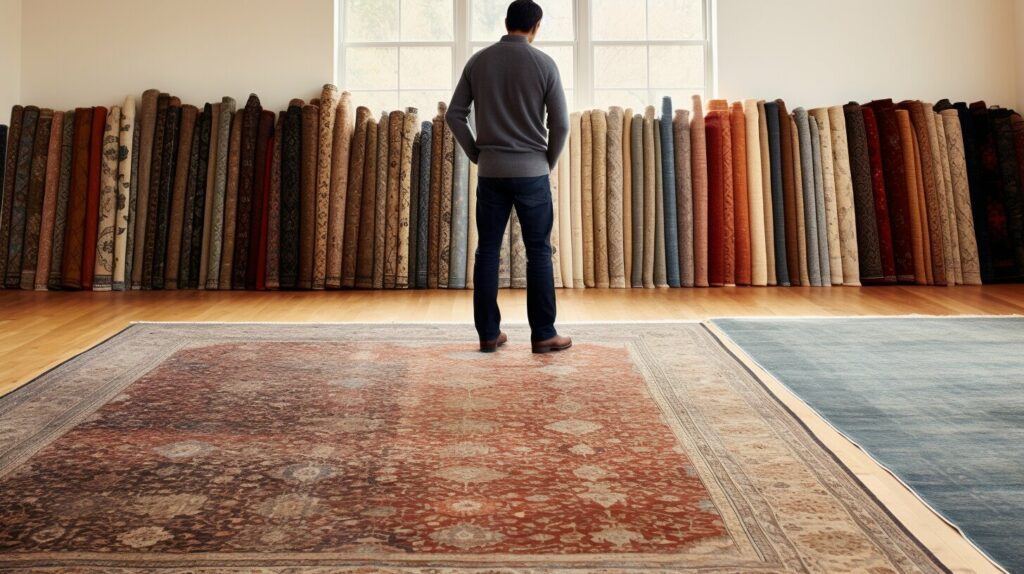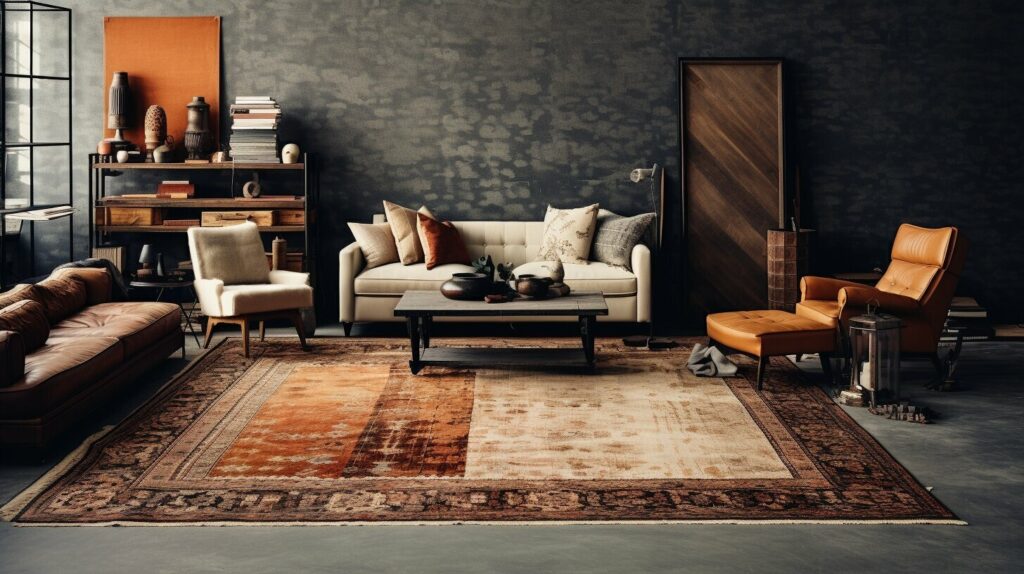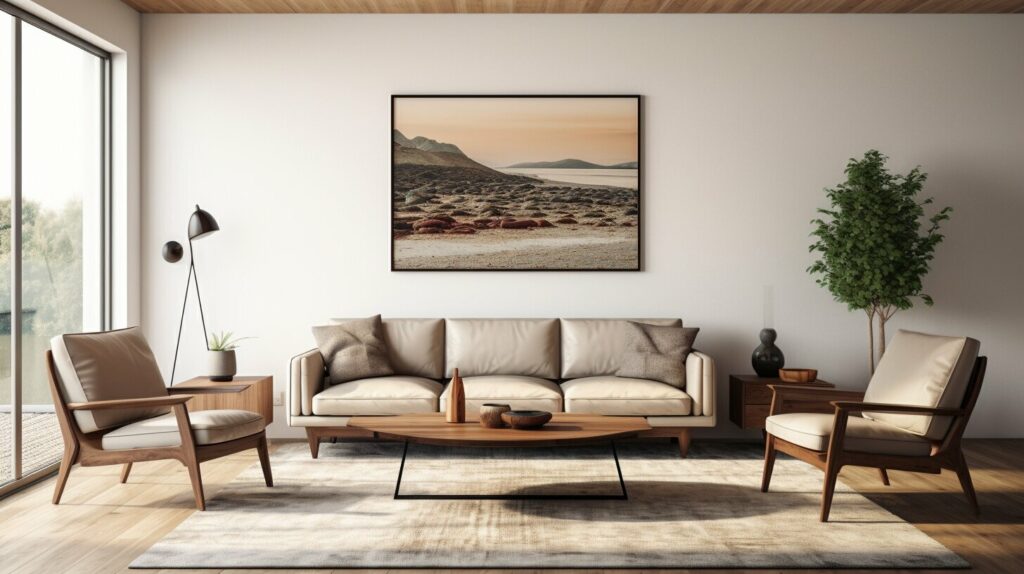Rug Selection Tips

Choosing the right rug size and material is crucial for achieving the desired look and functionality in a room. Whether you’re furnishing a large living room or a cozy bedroom, these tips will help you make the best decision for your space.
Key Takeaways:
- Consider the size of the room when choosing a rug; larger rooms require larger rugs to accommodate furniture and create a balanced look.
- For smaller rooms, opt for smaller rugs that provide coverage while leaving some space around the edges.
- When selecting a rug for a bedroom, go for an 8×10 or larger size to ensure it fits comfortably under the bed and extends beyond the bed’s edges.
- In dining rooms, choose a rug that extends at least 24 inches around all sides of the table to accommodate chairs when they are pulled out.
- Consider the material of the rug based on factors such as durability and ease of cleaning. Natural fibers like wool, cotton, silk, jute, and sisal are excellent choices. Synthetic fibers such as acrylic, polyester, and polypropylene are more affordable and stain-resistant.
- Be cautious with viscose rugs, as they are prone to damage and should be used in low-traffic areas.
- Take into account the pile height of the rug, which can be low or high depending on the level of plushness you desire.
- Protect your rug and prevent slipping by using a rug pad, which also helps to extend the lifespan of the rug.
Factors to Consider When Selecting a Rug Size
Choosing the right rug size is crucial to achieve the desired look and functionality in each room of your home. Whether you have a spacious living room or a cozy bedroom, finding the perfect size rug can enhance the overall aesthetic appeal and create a comfortable space.
For larger rooms, such as living rooms or open-concept spaces, it is recommended to go for a larger rug, such as 8×10 or 9×12, that can encompass the major furniture pieces while leaving a bit of space between the rug and the wall. This creates a defined gathering area and adds a sense of coziness to the room.
In smaller rooms, a 5×8 or 6×9 rug may be sufficient to anchor the furniture and add warmth to the space. This size allows for the front legs of the sofa and chairs to rest on the rug, providing a cohesive look and creating a cozy atmosphere.
When placing a rug in a bedroom, it’s important to consider the scale of the room. An 8×10 or larger rug is ideal as it provides enough coverage under the bed, extending beyond the sides and foot of the bed. This creates a soft and plush surface to step onto when getting in and out of bed, adding a touch of luxury to your morning routine.
| Room | Ideal Rug Size |
|---|---|
| Living Room | 8×10 or 9×12 |
| Bedroom | 8×10 or larger |
| Dining Room | Extend at least 24 inches around all sides of the table |

Remember, the size of the rug should be proportional to the room and the furniture in it. It’s important to measure the space accurately before making a purchase to ensure the rug fits perfectly and enhances the overall aesthetic of the room.
In the next section, we will explore different rug materials and their durability, helping you make an informed decision when selecting the perfect rug for your home.
Understanding Rug Materials and Durability
When selecting a rug, it’s important to understand the different materials available and their durability. The material of a rug not only affects its appearance but also its longevity and ease of maintenance. Natural fibers like wool, cotton, silk, jute, and sisal are known for their durability and ability to withstand everyday use.
Wool rugs are particularly popular due to their natural resistance to stains, dirt, and fading. They have a soft and luxurious feel underfoot and are suitable for high-traffic areas. Cotton rugs, on the other hand, are lightweight and easy to clean, making them a practical choice for kitchens and bathrooms. Silk rugs add a touch of elegance with their lustrous sheen, but they require more delicate care and are best suited for low-traffic areas.
For those looking for more affordable options, synthetic fibers like acrylic, polyester, and polypropylene are excellent choices. Acrylic rugs mimic the look and feel of wool, making them a budget-friendly alternative. Polyester rugs are known for their stain resistance and color-fastness, making them ideal for homes with children or pets. Polypropylene rugs are highly durable and resistant to moisture, making them suitable for outdoor or high-moisture areas like basements.
| Rug Material | Durability | Ease of Maintenance |
|---|---|---|
| Wool | High | Moderate |
| Cotton | Moderate | High |
| Silk | Low | High |
| Acrylic | Moderate | High |
| Polyester | Moderate | High |
| Polypropylene | High | High |
It’s important to note that viscose rugs, although visually appealing, are not as durable as other materials. Viscose rugs should be used in low-traffic areas to prevent damage and maintain their beauty. When in doubt, consult with a rug expert or follow the manufacturer’s care instructions to ensure the longevity of your rug.

- Consider the level of foot traffic in the area where the rug will be placed. High-traffic areas require more durable materials like wool or synthetic fibers.
- Think about the desired look and feel. Wool rugs offer warmth and luxury, while synthetic fibers provide affordability and ease of maintenance.
- Take into account any specific needs or concerns such as allergies or the presence of children or pets. Some materials may be more resistant to stains or allergens.
- Don’t forget to measure the space to ensure a proper fit. Consider the size and shape of the room when selecting the dimensions of your rug.
- Always check the care instructions for the rug material to ensure you can provide the necessary maintenance and prolong its lifespan.
Expert advice: “Choosing the right rug material is crucial in creating a functional and visually appealing space. Consider your lifestyle, budget, and desired aesthetic to make the best choice for your home.” – Jane Doe, Interior Designer
Choosing the Right Rug Material for Your Needs
Each rug material has its own unique characteristics, and selecting the right one for your needs can make a significant difference. When choosing a rug material, it’s essential to consider factors such as durability, ease of cleaning, and texture. Here is a breakdown of popular rug materials and their suitability for different requirements:
1. Natural Fibers:
Natural fiber rugs, including wool, cotton, silk, jute, and sisal, are known for their durability and ease of cleaning. Wool rugs, in particular, are long-lasting and naturally stain-resistant. They provide warmth and softness underfoot, making them suitable for living rooms, bedrooms, and high-traffic areas. Cotton rugs are affordable, lightweight, and easy to clean, making them a practical choice for kitchens and bathrooms.
On the other hand, silk rugs are luxurious and delicate, best suited for low-traffic areas. Jute and sisal rugs have a rustic charm and are great for adding texture to a space. However, they may not be as easy to clean as wool or cotton rugs, so it’s important to consider your maintenance preferences before making a choice.
2. Synthetic Fibers:
Synthetic fiber rugs, including acrylic, polyester, and polypropylene, are more budget-friendly options that offer excellent stain resistance. Acrylic rugs have a wool-like appearance and are resistant to fading, making them suitable for areas exposed to sunlight. Polyester rugs are durable, easy to clean, and often have a luxurious feel. Polypropylene rugs are highly stain-resistant and can withstand heavy foot traffic, making them a popular choice for families with children and pets.
It’s important to note that viscose rugs, although they have a soft and silky feel, are not ideal for high-traffic areas as they are prone to damage and difficult to clean. Therefore, it’s best to use viscose rugs in low-traffic areas like bedrooms or formal living rooms.

- Consider your needs and preferences when selecting a rug material: durability, ease of cleaning, and texture.
- For long-lasting and stain-resistant options, natural fiber rugs like wool or cotton are excellent choices.
- If you’re on a budget, synthetic fiber rugs such as acrylic, polyester, and polypropylene offer a cost-effective solution with good stain resistance.
- Avoid using viscose rugs in high-traffic areas, as they are prone to damage and difficult to clean.
By understanding the characteristics of different rug materials and choosing the one that aligns with your needs, you can ensure that your rug not only enhances the aesthetic appeal of your space but also stands the test of time.
Considering Pile Height for Comfort and Plushness
The pile height of a rug can greatly affect its comfort and plushness, so it’s important to consider this factor when making your selection. Pile height refers to the thickness of the fibers used in the construction of the rug. Whether you prefer a soft and cozy feel or a more low-profile look, understanding the different options available will help you find the ideal rug for your space.
When it comes to pile height, there are two main types: low pile and high pile. Low pile rugs have shorter fibers, which create a flatter surface and offer a smoother texture. These rugs are often easier to clean and maintain, making them a practical choice for high-traffic areas or homes with pets or children. On the other hand, high pile rugs have longer fibers, resulting in a deeper and more luxurious feel. These rugs can add warmth and comfort to a room, making them perfect for bedrooms or cozy living spaces.
It’s important to note that pile height can also affect the overall appearance of a rug. Low pile rugs tend to have a more contemporary and sleek look, while high pile rugs create a sense of opulence and elegance. Consider the style and aesthetic of your room when choosing the pile height to ensure it complements the overall design.
**Finish the text with an HTML table**:
| Rug Pile Height | Comfort Level | Plushness |
|---|---|---|
| Low pile | Less cushioned | Smoother texture |
| High pile | More cushioned | Soft and luxurious texture |
Protecting Your Rug with a Rug Pad
To ensure the longevity and safety of your rug, using a rug pad is highly recommended. Rug pads not only help to prevent slipping and sliding, but they also provide an extra layer of cushioning, making your rug more comfortable to walk on. Plus, rug pads help to protect your floors from scratches and damage caused by the constant friction of the rug against the surface.
When selecting a rug pad, it is important to consider the size and type of your rug. Measure your rug and choose a pad that is slightly smaller than the rug size to ensure it remains hidden beneath the edges. For example, if you have an 8×10 rug, look for a rug pad that is 7’6″x9’6″. Additionally, consider the type of flooring you have. For hard floors like hardwood or tile, a felt or rubber rug pad is ideal, as it provides both cushioning and grip. For carpeted areas, a thinner non-slip rug pad will prevent the rug from bunching up or shifting.
Benefits of Using a Rug Pad:
- Prevents slipping and sliding
- Provides cushioning and comfort
- Protects floors from scratches and damage
- Extends the lifespan of your rug
- Allows for easier vacuuming and cleaning
“A rug pad is like a foundation for your rug. It not only keeps the rug in place, but it also provides added comfort and protection for your floors.” – Interior Design Expert
Investing in a high-quality rug pad is a smart decision that will pay off in the long run. It ensures that your rug stays in place, reduces the risk of accidents caused by slipping rugs, and protects both your rug and floors from unnecessary wear and tear. With a rug pad in place, you can enjoy the beauty and functionality of your rug for years to come.

| Rug Pad Size | Rug Size |
|---|---|
| 4′ x 6′ | 3′ x 5′ |
| 5′ x 8′ | 4′ x 6′ |
| 8′ x 10′ | 7’6″ x 9’6″ |
| 9′ x 12′ | 8′ x 10′ |
Design Considerations for Rug Selection
Beyond the practical aspects, the design of a rug plays a vital role in enhancing the aesthetic appeal of your home. Choosing the perfect rug involves considering the color, pattern, and style that will complement your existing decor and create a cohesive look in your space.
When it comes to color, think about the overall color scheme of the room. Do you want the rug to be a bold statement piece or a subtle accent? Consider the mood you want to create – warm and cozy, or light and airy. Neutral colors like beige, gray, and ivory are versatile and can easily blend with different design schemes, while bolder colors can add a pop of vibrancy to your room.
Patterns can also make a significant impact on the overall design. Geometric patterns can add a modern and contemporary touch, while floral patterns can bring a sense of elegance and femininity. If your room already has bold patterns in the furniture or wallpaper, consider opting for a more understated rug design to avoid overwhelming the space.
The style of the rug should also reflect your personal taste and the overall style of your home. Traditional rugs with intricate designs and borders can add a touch of sophistication. On the other hand, if you prefer a more minimalist and contemporary look, consider rugs with clean lines and simple patterns. Don’t be afraid to mix and match different styles to create a unique and eclectic vibe.
Remember, the design of your rug should complement and enhance your existing decor, so take your time to find the perfect rug that will not only tie the room together but also express your personal style.
Now that you have a better understanding of the design considerations for rug selection, you can confidently choose a rug that not only fits your practical needs but also adds beauty and style to your home.

| Design Considerations | Rug Selection Tips |
|---|---|
| Color | Consider the color scheme of the room and choose a rug color that complements it. Neutral colors are versatile, while bolder colors can add vibrancy. |
| Pattern | Decide on a pattern that suits your style and complements the overall design. Consider the impact of geometric and floral patterns. |
| Style | Choose a rug style that reflects your personal taste and matches the overall style of your home. Traditional or contemporary styles are popular choices. |
Cleaning and Maintenance Tips for Rugs
Proper cleaning and maintenance of your rug are essential to keep it looking beautiful and extend its lifespan. Regular vacuuming is the first step in maintaining your rug’s cleanliness. Use a vacuum cleaner with a beater bar or rotating brush for deep cleaning and to remove dirt and dust from the rug fibers. Be sure to vacuum both sides of the rug for thorough cleaning.
In addition to regular vacuuming, it is recommended to shake out or beat the rug outdoors to remove embedded dirt and dust. This can help prolong the life of the rug and prevent it from becoming dull and worn-looking.
When dealing with spills or stains, it is important to act quickly. Blot the spill with a clean cloth or paper towel to absorb as much liquid as possible. Avoid rubbing the stain, as this can cause it to spread and become more difficult to remove. Depending on the type of stain and rug material, you may need to use a mild detergent or carpet cleaner to treat the spot. Always test any cleaning solution on a small, inconspicuous area of the rug first to ensure it does not cause discoloration or damage.

In addition to regular cleaning, it is also important to rotate your rug periodically. This helps prevent uneven wear and tear, especially in high-traffic areas. It is recommended to rotate the rug every six months or so, or more frequently if needed.
Finally, consider professional cleaning for your rug every one to two years. Professional cleaning can remove deep-seated dirt and stains, refresh the rug’s appearance, and help restore its original beauty. Be sure to choose a reputable rug cleaning service that specializes in the specific material of your rug.
In summary, proper cleaning and maintenance of your rug are crucial for its longevity and to keep it looking its best. Remember to vacuum regularly, shake out or beat the rug, treat spills and stains promptly, rotate the rug periodically, and consider professional cleaning when needed. By following these tips, you can ensure that your rug remains a beautiful and functional centerpiece in your home for years to come.
Conclusion
By following these rug selection tips, you can confidently choose the perfect rug that will enhance your home decor and create a welcoming atmosphere.
When it comes to selecting the right rug size, consider the dimensions of the room and the furniture layout. In larger rooms, opt for a larger rug, such as an 8×10 or 9×12, that can encompass the major furniture pieces while leaving a bit of space between the rug and the wall. In smaller rooms, a 5×8 or 6×9 rug may be sufficient to anchor the space.
For bedrooms, it is recommended to choose an 8×10 or larger rug that extends beyond the bed, creating a cozy and luxurious feel. In dining rooms, the rug should extend at least 24 inches around all sides of the table, allowing ample space for chairs to be pulled out without catching on the edge of the rug.
When considering rug materials, natural fibers like wool, cotton, silk, jute, and sisal are not only durable but also easy to clean, making them ideal for high-traffic areas. If you’re on a budget or looking for a stain-resistant option, synthetic fibers such as acrylic, polyester, and polypropylene are more affordable and offer great resistance to stains. However, keep in mind that viscose rugs are prone to damage and should be used in low-traffic areas only.
Lastly, the plushness of the rug is determined by the pile height. For a more luxurious and comfortable feel, opt for a high pile rug. If you prefer a sleeker and easier-to-clean option, a low pile rug is a better choice. Don’t forget to protect your rug and prevent slipping by using a rug pad, which also helps to extend the life of your rug.
With these rug selection tips in mind, you can find the perfect rug that not only complements your existing decor but also suits your lifestyle and meets your functional needs. So go ahead and start exploring the wide variety of rugs available, and transform your space into a cozy and stylish haven.
FAQ
How do I choose the right size rug for my room?
For larger rooms, it is recommended to go for a larger rug, such as 8×10 or 9×12, that can encompass the major furniture pieces while leaving a bit of space between the rug and the wall. In smaller rooms, a 5×8 or 6×9 rug may be sufficient. Placing a rug in a bedroom requires extra consideration, with an 8×10 or larger rug being ideal. For dining rooms, the rug should extend at least 24 inches around all sides of the table.
What are the best rug materials to choose from?
Natural fibers like wool, cotton, silk, jute, and sisal are durable and easy to clean. Synthetic fibers such as acrylic, polyester, and polypropylene are more affordable and stain-resistant. Viscose rugs are prone to damage and should be used in low-traffic areas.
What is pile height and how does it affect the feel of a rug?
Pile height refers to the thickness of the rug fibers. Low pile rugs have shorter fibers, while high pile rugs have longer, more plush fibers. The choice of pile height depends on the desired level of comfort and plushness.
Why should I use a rug pad?
Using a rug pad is recommended to protect the rug and prevent slipping. It provides cushioning, improves longevity, and helps to keep the rug in place.
How do I clean and maintain my rug?
Cleaning and maintenance of rugs depend on their materials. Regular vacuuming, spot cleaning, and professional cleaning are recommended to keep your rug in top condition. Follow the specific care instructions for your rug’s material.
Rug Selection Tips
- Homes & Gardens: www.homesandgardens.com
- Rug Love: www.ruglove.co.uk
- House Beautiful: www.housebeautiful.com
- HGTV: www.hgtv.com

